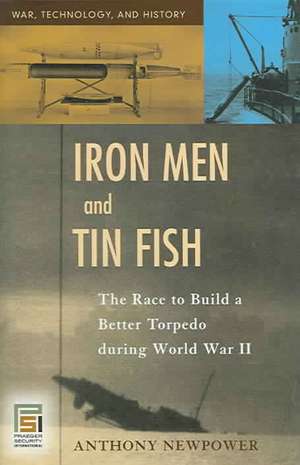Iron Men and Tin Fish: The Race to Build a Better Torpedo during World War II: War, Technology, and History
Autor Anthony Newpoweren Limba Engleză Hardback – 29 aug 2006 – vârsta până la 17 ani
Preț: 308.98 lei
Preț vechi: 359.08 lei
-14% Nou
Puncte Express: 463
Preț estimativ în valută:
59.12€ • 61.73$ • 48.93£
59.12€ • 61.73$ • 48.93£
Carte tipărită la comandă
Livrare economică 04-18 aprilie
Preluare comenzi: 021 569.72.76
Specificații
ISBN-13: 9780275990329
ISBN-10: 027599032X
Pagini: 256
Dimensiuni: 156 x 235 x 27 mm
Greutate: 0.55 kg
Editura: Bloomsbury Publishing
Colecția Praeger
Seria War, Technology, and History
Locul publicării:New York, United States
ISBN-10: 027599032X
Pagini: 256
Dimensiuni: 156 x 235 x 27 mm
Greutate: 0.55 kg
Editura: Bloomsbury Publishing
Colecția Praeger
Seria War, Technology, and History
Locul publicării:New York, United States
Notă biografică
Anthony Newpower is a graduate of the U.S. Naval Academy and a former naval officer. Newpower has lectured on submarine warfare at Southern Methodist University and is currently studying in the Honors program in Naval Warfare at the American Military University.
Cuprins
ContentsSeries ForewordPrefaceAcknowledgmentsPrologue1. Early Torpedo Development2. A Deadly New Application3. ". to Fight with a Wooden Gun"4. Deep Trouble (U.S. Torpedoes 7 December 1941-3 June 1942)5. Success beyond Expectations6. Lockwood to the Rescue7. Outclassed8. "We Don't Like Prematures"9. The Toothless Sharks10. A Weapon Worthy of the Crews It ServedEpilogueNotesBibliographyIndex
Recenzii
In the most comprehensive analysis of the topic to date, Newpower chronicles US torpedo problems, showing that they lasted until submariners simply stopped using the magnetic explorers. (Britain and Germany had abandoned them by 1941.) Officers in Australia conducted experiments that finally convinced BurOrd officials that depth regulators were defective. Newport Torpedo Station engineers then redesigned the depth regulators, and officers in Hawai'i solved the contact exploder problem on their own by redesigning the firing pin. Recommended. All levels/libraries.
Anthony Newpower has done excellent work. Backed by dedicated research that yielded astute studies of naval bureaucracy in early years of the war, Iron Men and Tin Fish casts new and refreshing light on popular perceptions of the MK 14 torpedo controversy.
A former naval officer examines the technical details and military politics behind the torpedoes developed by the United States, Germany, Britain, and Japan during 1941 and 1942 in response to navigation and detonation failures. The investigation focuses on the Mark 14 torpedo and relies on Bureau of Ordnance archives along with submarine veteran interviews.
Anthony Newpower has done excellent work. Backed by dedicated research that yielded astute studies of naval bureaucracy in early years of the war, Iron Men and Tin Fish casts new and refreshing light on popular perceptions of the MK 14 torpedo controversy.
A former naval officer examines the technical details and military politics behind the torpedoes developed by the United States, Germany, Britain, and Japan during 1941 and 1942 in response to navigation and detonation failures. The investigation focuses on the Mark 14 torpedo and relies on Bureau of Ordnance archives along with submarine veteran interviews.








